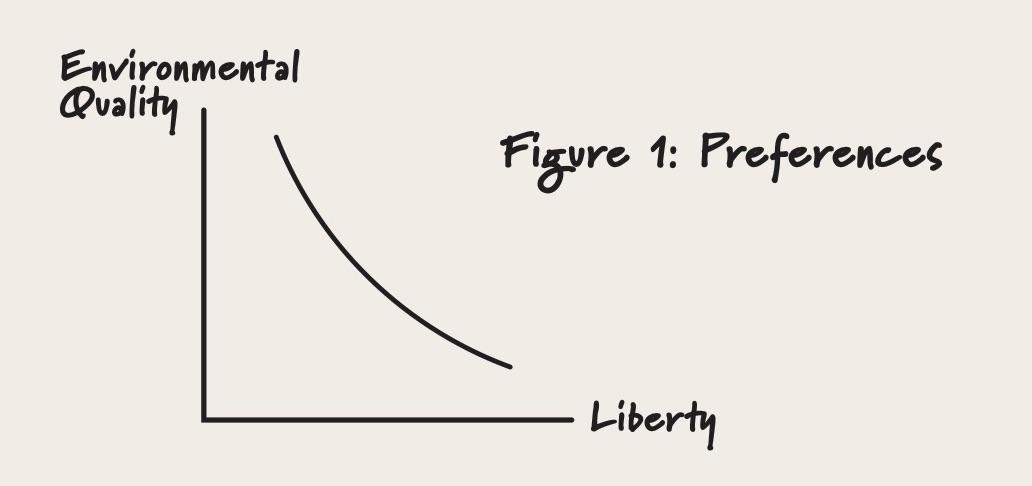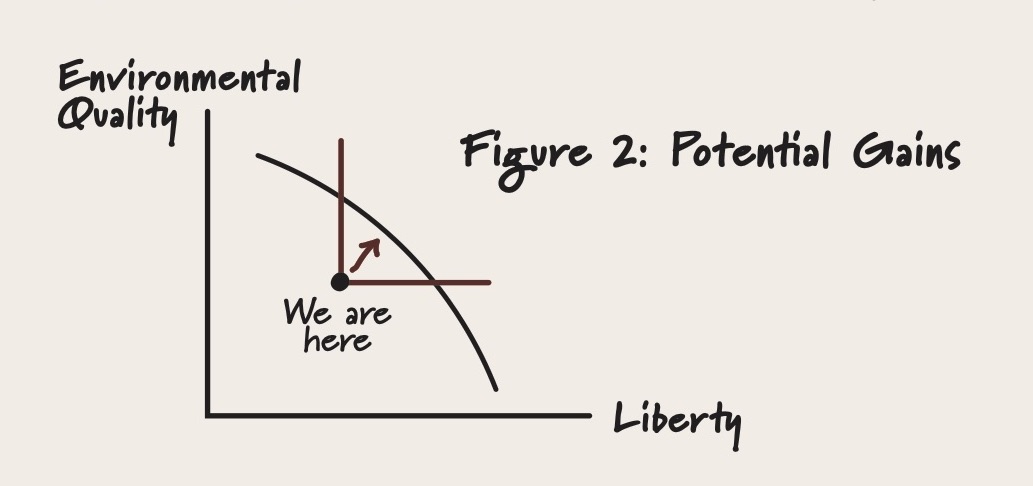PERC is the home of free market environmentalism. But what is free market environmentalism? A statement of principle? An economic theory? A political rallying cry? As someone with long-standing ties to PERC, I have learned to embrace the phrase, and in so doing have arrived at the interpretation I present here. It describes what I think binds together those who find an intellectual home at PERC.
My version of free market environmentalism involves a standard economic analysis of two goods: environmental quality and liberty. It describes someone who views increases in environmental quality as unambiguously good. The same person also views increases in liberty, or autonomy, as unambiguously good.
Some may find these assertions to be bland and unexceptionable, but counterexamples abound. Plenty of libertarians place a premium on liberty but are largely indifferent to the state of the natural world. Many environmentalists are passionate about endangered species and wilderness but are largely indifferent to the regulation of human activity imposed by collective coercion—in fact, may welcome the sense of community that can come with submitting to social order.
But free market environmentalism doesn’t rest on preferences alone. It involves the belief that the physical and policy worlds often offer trade-offs between liberty and the environment.
Using common economic assumptions, a free market environmentalist’s preferences for environmental quality and liberty are shown in Figure 1, which can be interpreted as follows. Vertical movements in the diagram represent improved environmental quality for a fixed level of liberty. Horizontal movements represent greater liberty for a fixed level of environmental quality. Both directions, and all combined movements in a northeastern direction, represent improvements in the state of the world.
Further, the figure represents a willingness to accept trade-offs as shown in the slope of the curve, which economists call an indifference curve. A southeast movement along the indifference curve represents the terms of trade the individual is willing to accept to increase liberty at the expense of environmental quality. The curve is convex because as the free market environmentalist gives up more and more environmental quality, he must be rewarded with a relatively greater amount of liberty to be equally satisfied—and vice versa. In other words, both environmental quality and liberty are like steak—the first bite is tastier than the last.
Adherents to free market environmentalism certainly differ in the degrees to which they prefer environmental quality and liberty, absolutely and at the margin: from staunch libertarians with a mild taste for greenery to hardcore environmentalists who would rather not be told what to do.
But free market environmentalism doesn’t rest on preferences alone. It involves the belief that the physical and policy worlds often offer trade-offs between liberty and the environment. A standard economic principle asserts that an economy faces a trade-off between guns and butter. The economy can devote all of its resources to the production of guns, all to the production of butter, or to combinations in between. Just as with guns and butter, the trade-offs between environmental quality and liberty can be represented with what economists call a production possibilities frontier, as shown in Figure 2.
An important point to understand is that the trade-offs happen on the frontier, represented by the concave curve, from which no northeast movements are possible. There may be situations inside the frontier where both liberty and environmental quality can be improved. But if the economy is operating on the frontier, then increasing environmental quality requires a reduction in the freedom of individuals to choose their own actions—a northwest movement along the curve. The trade-off here is perhaps less obvious than in the production of guns and butter. But the trade-off is implicit in every discussion of environmental regulation where it is proposed that firms or individuals be restricted from exercising their otherwise profit- or utility-maximizing choices to achieve a given environmental aim, whether lower atmospheric particulate count or higher grizzly bear population.
The tie that binds one to the mast of free market environmentalism is the observation that we live in an imperfect world—in other words, we are not on the frontier. Because our regulatory and legal structures and levels of environmental quality are to a great extent shared and publicly determined, there is no reason to think that we are at the optimum, or even that the optimum is well defined given a diversity of personal preferences and no unique way to aggregate them.
Adherents of free market environmentalism and fellow travelers at PERC subscribe to the view that we often find ourselves at a point like the one labeled “We are here” in Figure 2. From this point, it is possible to increase both environmental quality and liberty. We are not on the frontier, but we can and should try to move closer to it.
That’s it. The majority of the intellectual effort at PERC appears to me to be motivated by situations where northeast movements are possible. Some represent increases in liberty alone, some increases in environmental quality alone. The solutions most likely to attract broad interest are those that represent increases in both. It is the analysis of the details of individual cases that occupy economists, legal scholars, philosophers, political scientists, biologists, and ecologists at PERC.
Why, finally, is it “free market environmentalism?” Because markets are key. Markets are the central metaphor in economics to represent voluntary exchange. Free market environmentalism encourages environmental policy inspired by markets, thus promoting liberty and autonomy. In some cases, this involves using existing markets. In other cases, it requires attempting to design markets—with due respect for the law of unintended consequences and Hayekian insights into knowledge of “the particular circumstances of time and place.” In some cases, it means mimicking markets when designing non-market regulation.
And that is why PERC is the home of free market environmentalism.






